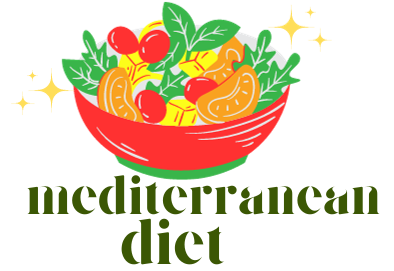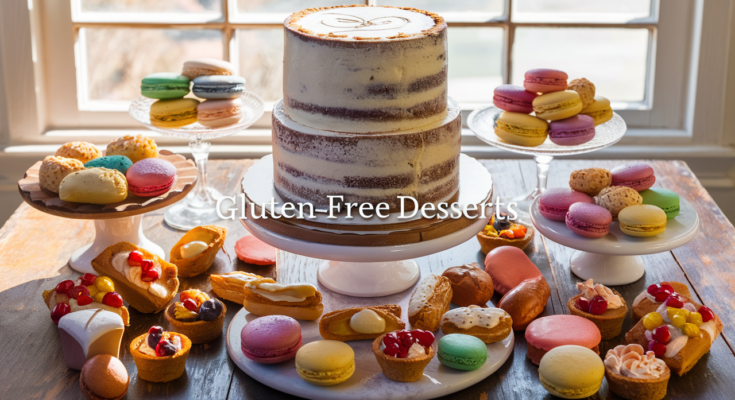Introduction
What comes to mind when you think of gluten-free desserts? If you imagine tasteless, dry, or crumbly treats, think again! Gluten-free desserts have come a long way and can be just as delicious, if not more so, than their gluten-filled counterparts. Whether you’re living with celiac disease, gluten sensitivity, or simply exploring healthier options, gluten-free baking offers a world of flavors and textures that everyone can enjoy.
The Basics of Gluten-Free Baking
Understanding Gluten and Its Role
Gluten is a protein found in wheat, barley, and rye. It gives dough its elasticity and helps it rise and hold its shape. Without gluten, baked goods can fall flat or become too crumbly. This is where gluten-free baking techniques come into play, using alternative flours and binding agents to mimic gluten’s effects.

Common Gluten-Free Flours
Almond Flour
Almond flour adds moisture and a nutty flavor to baked goods. It’s perfect for cakes and cookies but can be dense, so it’s often mixed with lighter flours.
Coconut Flour
Coconut flour is highly absorbent and adds a subtle sweetness. It’s great for creating light, fluffy baked goods, but you need to use it sparingly and with plenty of liquid.
Rice Flour
Rice flour is a versatile, neutral-tasting flour that’s good for all-purpose baking. It works well in combination with other flours to create a balanced texture.
Oat Flour
Oat flour adds a mild sweetness and extra fiber. Ensure it’s labeled gluten-free, as oats can be cross-contaminated with gluten during processing.
Binding Agents and Their Importance
Binding agents help hold gluten-free ingredients together, providing structure and stability.
Xanthan Gum
Xanthan gum is a common binding agent that mimics gluten’s elasticity. A little goes a long way, so use it sparingly.
Guar Gum
Guar gum is another popular binder, often used in conjunction with xanthan gum. It adds softness and chewiness to baked goods.
Eggs
Eggs are natural binders that add moisture and richness. For vegan recipes, flax or chia seeds can be used as egg substitutes.
Flax Seeds
Flax seeds mixed with water create a gel-like substance that works well as an egg replacement in many recipes.
Essential Tips for Gluten-Free Baking
The Art of Mixing Flours
Combining different gluten-free flours can achieve a better texture and flavor. For example, almond flour adds moisture while coconut flour absorbs liquid, creating a balanced mix.
Importance of Binders
Binders like xanthan gum, guar gum, or eggs are crucial for providing structure and preventing crumbling. Don’t skip these essential ingredients.
Accurate Measurement Techniques
Gluten-free flours are more finicky than wheat flour. Accurate measurements are key to avoiding overly dry or dense textures.
Letting Batter Rest for Better Texture
Allowing the batter to rest for 10-15 minutes lets the flours hydrate properly, resulting in a smoother texture and preventing grittiness.
My Gluten-Free Journey
Initial Challenges and Missteps
Starting my gluten-free journey five years ago, I felt overwhelmed by the thought of giving up my favorite baked goods. The first few attempts were disastrous, with cookies that could double as hockey pucks.
First Successful Recipe
One of my first successes was a batch of gluten-free brownies that my friends and family couldn’t believe were gluten-free. This opened my eyes to the endless possibilities of gluten-free baking.
Lessons Learned Along the Way
Through experimentation, I discovered the importance of mixing flours and using binders. I learned to let dough rest and the magic of combining different gluten-free flours.
Popular Gluten-Free Desserts
Flourless Chocolate Cake
This rich, dense cake is a chocolate lover’s dream and doesn’t require any special gluten-free flours.
Gluten-Free Lemon Bars
These tangy and sweet lemon bars have a buttery crust and a luscious lemon filling, perfect for a summer treat.
Almond Flour Blueberry Muffins
These muffins are moist, fluffy, and bursting with fresh blueberries. They make a perfect breakfast or snack.
Recipe: Flourless Chocolate Cake
Ingredients:
- 1 cup (225g) unsalted butter
- 1 cup (200g) granulated sugar
- 1 cup (175g) dark chocolate chips
- 6 large eggs
- 1 teaspoon vanilla extract
- A pinch of salt
Instructions:
- Preheat your oven to 375°F (190°C). Grease an 8-inch round cake pan and line it with parchment paper.
- Melt the butter and chocolate together in a double boiler or microwave until smooth.
- In a large bowl, beat the eggs with the sugar, vanilla, and salt until thick and pale.
- Fold the chocolate mixture into the egg mixture until well combined.
- Pour the batter into the prepared pan and bake for 25-30 minutes. The center should be just set but still slightly gooey.
- Let the cake cool in the pan before turning it out. Dust with cocoa powder or powdered sugar before serving.

Recipe: Gluten-Free Lemon Bars
Ingredients:
- For the crust:
- 1 cup (120g) gluten-free flour blend
- 1/2 cup (113g) unsalted butter, cold and cubed
- 1/4 cup (30g) powdered sugar
- For the filling:
- 1 cup (200g) granulated sugar
- 2 large eggs
- 1/4 cup (30g) gluten-free flour blend
- 1/2 cup (120ml) fresh lemon juice
- Zest of 1 lemon
Instructions:
- Preheat your oven to 350°F (175°C). Grease an 8×8-inch baking dish and line with parchment paper.
- For the crust, combine the flour and powdered sugar in a bowl. Cut in the butter until the mixture resembles coarse crumbs. Press into the bottom of the prepared dish.
- Bake the crust for 15-20 minutes, until lightly golden.
- For the filling, whisk together the sugar, eggs, flour, lemon juice, and zest until smooth. Pour over the baked crust.
- Bake for an additional 20-25 minutes, until the filling is set and the edges are lightly browned.
- Let cool completely before cutting into bars. Dust with powdered sugar before serving.
Recipe: Almond Flour Blueberry Muffins
Ingredients:
- 2 cups (240g) almond flour
- 1/4 cup (30g) coconut flour
- 1/2 teaspoon baking soda
- 1/4 teaspoon salt
- 3 large eggs
- 1/4 cup (60ml) honey or maple syrup
- 1/4 cup (60ml) melted coconut oil
- 1 teaspoon vanilla extract
- 1 cup (150g) fresh or frozen blueberries
Instructions:
- Preheat your oven to 350°F (175°C) and line a muffin tin with paper liners.
- In a large bowl, whisk together the almond flour, coconut flour, baking soda, and salt.
- In another bowl, whisk together the eggs, honey, coconut oil, and vanilla extract.
- Combine the wet and dry ingredients until just mixed. Fold in the blueberries.
- Divide the batter evenly among the muffin cups.
- Bake for 20-25 minutes, until a toothpick inserted into the center comes out clean.
- Let the muffins cool in the tin for 10 minutes before transferring to a wire rack to cool completely.
Alternative Ingredients for Gluten-Free Baking
Natural Sweeteners
Honey
Honey adds moisture and a rich flavor. It’s great for cookies and cakes, providing a natural sweetness.
Maple Syrup
Maple syrup offers a subtle caramel flavor. It’s perfect for pancakes, muffins, and other baked goods.
Coconut Sugar
Coconut sugar has a low glycemic index and adds a subtle caramel flavor. It’s an excellent substitute for brown sugar.
Dairy Substitutes
Almond Milk
Almond milk is a light and nutty alternative to dairy milk. It’s perfect for most baking recipes.
Coconut Milk
Coconut milk adds richness and a hint of coconut flavor. It’s great for cakes, muffins, and even ice cream.
Soy Milk
Soy milk is another versatile dairy substitute, with a neutral flavor that works well in most recipes.
Egg Replacements
Flax Eggs
Flax eggs are made by mixing ground flax seeds with water. They work well in cookies, muffins, and quick breads.
Chia Eggs
Chia eggs are similar to flax eggs and can be used in the same way. They add moisture and help bind ingredients together.
Enhancing Flavor and Texture in Gluten-Free Desserts
Adding Moisture
Gluten-free baked goods can sometimes be dry. Adding ingredients like applesauce, yogurt, or mashed bananas can help retain moisture.
Using Spices and Extracts
Enhance the flavor of your desserts with spices like cinnamon, nutmeg, and ginger. Vanilla and almond extracts can also add depth to your baked goods.
Presentation Tips for Aesthetic Appeal
Presentation matters! Use fresh fruit, edible flowers, or a dusting of powdered sugar to make your gluten-free desserts look as good as they taste.
Personal Anecdotes: Successes and Fails
Baking Disasters and How to Avoid Them
I’ve had my fair share of baking disasters, from rock-hard cookies to crumbling cakes. The key is to learn from these mistakes and keep experimenting.
Favorite Recipes and Family Reactions
One of my favorite recipes is the flourless chocolate cake. My family loves it, and they often request it for special occasions. Their positive reactions motivate me to keep exploring new gluten-free recipes.
Health Benefits of Gluten-Free Desserts
Nutritional Advantages
Gluten-free desserts can be packed with nutrients, especially when using whole grains and natural sweeteners.
Digestive Health
For those with gluten intolerance or celiac disease, gluten-free desserts are a necessity. They can help alleviate digestive issues and promote better gut health.
Overall Wellbeing
Gluten-free desserts can contribute to overall wellbeing by providing healthier alternatives to traditional treats. They can be lower in sugar and higher in fiber and protein.
Common Mistakes in Gluten-Free Baking
Overmixing the Batter
Overmixing can lead to dense and tough baked goods. Mix until just combined for the best results.
Not Allowing Enough Rest Time
Letting the batter rest allows the flours to hydrate properly, leading to a better texture. Don’t skip this step!

Incorrect Flour Substitutions
Not all gluten-free flours are created equal. Each has unique properties, so substituting one for another can drastically change the outcome.
Storing and Preserving Gluten-Free Desserts
Best Practices for Storage
Store gluten-free desserts in airtight containers to keep them fresh. Some may need refrigeration, especially those with perishable ingredients.
Freezing Tips and Tricks
Many gluten-free desserts freeze well. Wrap them tightly and store them in freezer-safe bags or containers for up to three months.
Shelf Life Considerations
Gluten-free baked goods may have a shorter shelf life than their gluten counterparts. Check for freshness before serving, especially if they’ve been stored for a while.
Conclusion
Gluten-free baking is an exciting journey filled with learning and delicious discoveries. By understanding the basics, experimenting with different flours and binders, and following tried-and-true recipes, you can create gluten-free desserts that are just as delightful as traditional ones. Whether you’re new to gluten-free baking or a seasoned pro, there’s always something new to explore and enjoy.
FAQs
Can I Substitute Regular Flour with Gluten-Free Flour in Any Recipe?
Not always. Gluten-free flours have different properties, so it’s best to use recipes specifically designed for them.
Are Gluten-Free Desserts Healthier Than Regular Desserts?
They can be, especially when using whole grains and natural sweeteners. However, they can also be just as indulgent.
How Do I Prevent Gluten-Free Desserts from Being Dry?
Use ingredients like applesauce, yogurt, or mashed bananas to add moisture. Accurate measurement and letting the batter rest also help.
What Are Some Quick and Easy Gluten-Free Dessert Recipes?
Flourless chocolate cake, gluten-free lemon bars, and almond flour blueberry muffins are great starting points.
Can Gluten-Free Desserts Be Made Vegan?
Yes, many gluten-free desserts can be made vegan by using egg replacements like flax or chia eggs and dairy substitutes like almond or coconut milk.

